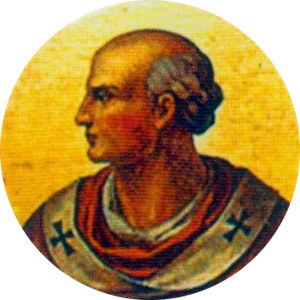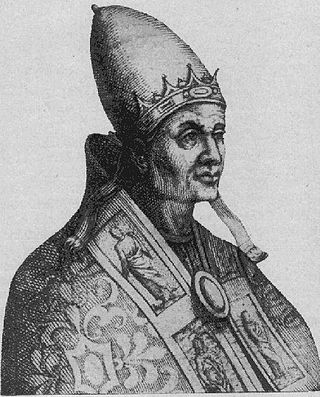Pope Benedict VIII was bishop of Rome and ruler of the Papal States from 18 May 1012 until his death. He was born Theophylact to the noble family of the counts of Tusculum. Unusually for a medieval pope, he had strong authority both in Rome and abroad.
Pope Benedict IX, born Theophylactus of Tusculum in Rome, was the bishop of Rome and ruler of the Papal States for three periods between October 1032 and July 1048. Aged about 20 when first elected, he is one of the youngest popes in history. He is the only person to have been Pope more than once and the only person ever accused of selling the papacy.
Pope Sylvester III, born John in Rome, was Bishop of Rome and hence ruler of the Papal States from 20 January to March 1045.

Benedict X, born Giovanni, was elected to succeed Pope Stephen IX on 5 April 1058, but was opposed by a rival faction that elected Nicholas II. He fled Rome on 24 January 1059 and is today generally regarded as an antipope.

Marozia, born Maria and also known as Mariuccia or Mariozza, was a Roman noblewoman who was the alleged mistress of Pope Sergius III and was given the unprecedented titles senatrix ("senatoress") and patricia of Rome by Pope John X.
Pope John X was the bishop of Rome and nominal ruler of the Papal States from March 914 to his death. A candidate of the counts of Tusculum, he attempted to unify Italy under the leadership of Berengar of Friuli, and was instrumental in the defeat of the Saracens at the Battle of Garigliano. He eventually fell out with Marozia, who had him deposed, imprisoned, and finally murdered. John’s pontificate occurred during the period known as the Saeculum obscurum.

Saeculum obscurum, also known as the Pornocracy or the Rule of the Harlots, was a period in the history of the Papacy during the first two-thirds of the 10th century, following the chaos after the death of Pope Formosus in 896 which saw seven or eight papal elections in as many years. It began with the installation of Pope Sergius III in 904 and lasted for sixty years until the death of Pope John XII in 964. During this period, the popes were influenced strongly by a powerful and allegedly corrupt aristocratic family, the Theophylacti, and their relatives and allies. The era is seen as one of the lowest points of the history of the Papal office.

The Crescentii were a baronial family, attested in Rome from the beginning of the 10th century and which in fact ruled the city and the election of the popes until the beginning of the 11th century.
Theophylact I was a medieval count of Tusculum who was the effective ruler of Rome from around 905 through to his death in 924. His descendants controlled the papacy for the next 100 years.
Benedict has been the papal name of fifteen Roman Catholic popes. The name is derived from the Latin benedictus, meaning "blessed".
Alberic I was the Lombard Duke of Spoleto from between 896 and 900 until 920, 922, or thereabouts. He was also Margrave of Camerino, and the son-in-law of Theophylact I, Count of Tusculum, the most powerful man in Rome.
Ptolemy I was the count of Tusculum in the first quarter of the twelfth century. He was a son of Gregory III. Peter Pisanus, in his Vita Paschalis II refers to Ptolemy and the abbot of Farfa as the allies of the emperor in the same way that the Saints Peter and Paul were the allies of the pope.
Ptolemy II was the count of Tusculum and consul of the Romans from 1126 to his death. He was the son and successor of Ptolemy I.
Jonathan was the count of Tusculum from the death of his father, Ptolemy II, in 1153 to his own death. His mother was Bertha, illegitimate daughter of Henry V, Holy Roman Emperor.
Raino, also Rayno, Ranulf, or Reginulf, was the last count of Tusculum from an unknown date when he was first associated with his elder brother, Jonathan, to his own death. His father, Ptolemy II, died in 1153. His mother was Bertha, illegitimate daughter of Henry V, Holy Roman Emperor.
Gregory I was the Count of Tusculum sometime between 954 and 1012. Consul et dux 961, vir illustrissimus 980, praefectus navalis 999. He was the son of Alberic II, and Alda of Vienne. His half-brother was Pope John XII.
Gregory II was the son of Alberic III, Count of Tusculum and Ermelina. He was the Count of Tusculum and the Lateran from 1044 to his death.
Alberic III was the Count of Tusculum, along with Galeria, Preneste, and Arce, from 1024, when his brother the count Roman was elected Pope John XIX, until his own death. He was a son of Gregory I and Maria, brother of Popes Benedict VIII and John XIX, and brother-in-law of Thrasimund III of Spoleto.
Peter was a medieval Roman noble. Like his father, he carried the illustrious title of Romanorum patricius, consul, dux et senator, implying his secular command over Rome and its militia. He was the son of Alberic III, Count of Tusculum. As a result, he was a descendant of Theophylact I, Count of Tusculum.

The Tusculan Papacy was a period of papal history from 1012 to 1048 where three successive relatives of the counts of Tusculum were installed as pope.





